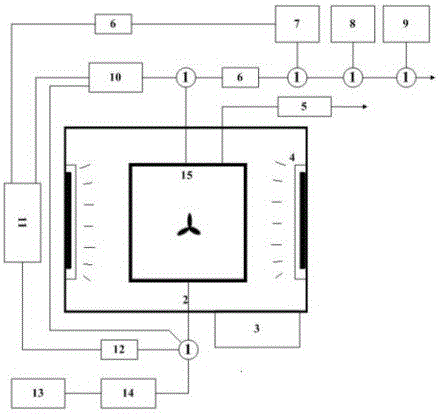Method and device for studying mechanism that secondary organic aerosol is produced by photo-oxidation transformation of fuel coal
An aerosol and photo-oxidation technology, which is applied in the direction of measuring devices, chemical analysis by combustion, particle and sedimentation analysis, etc., can solve the problems of lack and lack of research systems, etc., and achieve the effect of simple operation and strong practicability
- Summary
- Abstract
- Description
- Claims
- Application Information
AI Technical Summary
Problems solved by technology
Method used
Image
Examples
Embodiment 1
[0024] In this example, see figure 1 , a device for studying the mechanism of secondary organic aerosol generated by coal-burning photo-oxidation, consisting of a gas distribution system, a static coal denudation experiment analysis system, a static coal combustion experiment analysis system, a dynamic coal combustion photo-oxidation experiment analysis system and corresponding connecting pipes The gas distribution system consists of a zero air generator 13, a gas distribution platform 14 and a multi-way valve 1. The zero air generator 13 delivers air to the gas distribution platform 14 and then enters an inlet of the multi-way valve 1. Static coal erosion The experimental analysis system includes a single particle aerosol mass spectrometer 10, and the raw coal particles are sent into the single particle aerosol mass spectrometer 10 through the gas distribution system, and the chemical composition and particle size analysis are performed to obtain the chemical composition and p...
Embodiment 2
[0037] This embodiment is basically the same as Embodiment 1, especially in that:
[0038] In this embodiment, the photochemical test and analysis system of the dynamic coal combustion photooxidation experimental analysis system also includes a gas chromatograph, which performs gas chromatographic auxiliary analysis on the secondary reaction products of coal burning photochemistry, and combines the detected gas chromatographic auxiliary analysis data As an analysis of the intermediate state data of coal in the photochemical reaction, through multi-dimensional data analysis, the mechanism of the formation of secondary organic aerosols from the photooxidation of coal can be more accurately obtained.
PUM
 Login to View More
Login to View More Abstract
Description
Claims
Application Information
 Login to View More
Login to View More - R&D
- Intellectual Property
- Life Sciences
- Materials
- Tech Scout
- Unparalleled Data Quality
- Higher Quality Content
- 60% Fewer Hallucinations
Browse by: Latest US Patents, China's latest patents, Technical Efficacy Thesaurus, Application Domain, Technology Topic, Popular Technical Reports.
© 2025 PatSnap. All rights reserved.Legal|Privacy policy|Modern Slavery Act Transparency Statement|Sitemap|About US| Contact US: help@patsnap.com

